
Teespring vs Shopify: Which is Better for POD Business in 2025?
Thinking about launching your own merch or print-on-demand (POD) business? You’ve probably come across the comparison of Teespring vs Shopify – two of the most talked-about platforms for selling custom products online, but with very different approaches.
Teespring is built for simplicity: you design, they handle the rest. Shopify gives you the tools to build a fully branded online store from the ground up. If you’re a creator, side hustler, or aspiring entrepreneur trying to decide between the two, you’re in the right place.
In this guide, you’ll learn:
- How Teespring and Shopify differ in setup, ease of use, and launch speed
- What each platform costs and how that impacts your profit margins
- How much creative and brand control you actually get
- What product and store options are available on each
- How each platform handles fulfillment, apps, and integrations
- Who owns the customer data and why it matters for growth
- Which offers better tools for marketing, SEO, and long-term success
Let’s get in!
Teespring vs Shopify: A Quick Overview
Before diving into the details, it’s important to understand what Teespring and Shopify actually are and why this comparison matters if you’re planning to sell print-on-demand products in 2025.
What is Teespring (Spring)?
Teespring is a marketplace-based print-on-demand platform that allows you to create and sell custom products like t-shirts, mugs, and stickers without handling inventory, fulfillment, or customer service. It’s designed for speed and simplicity which is primarily targeting creators who want to monetize their audience with minimal effort. Products are sold through Teespring-hosted pages, and fulfillment is handled entirely by the platform.

What is Shopify?
Shopify is a eCommerce platform that lets you build and manage your own online store. While it doesn’t offer built-in print-on-demand services, you can connect your store to top POD apps like Printful, Printify, or Gelato. Shopify gives you full control over your storefront, branding, pricing, customer data, and marketing, making it a better fit for sellers looking to build a long-term business or brand.
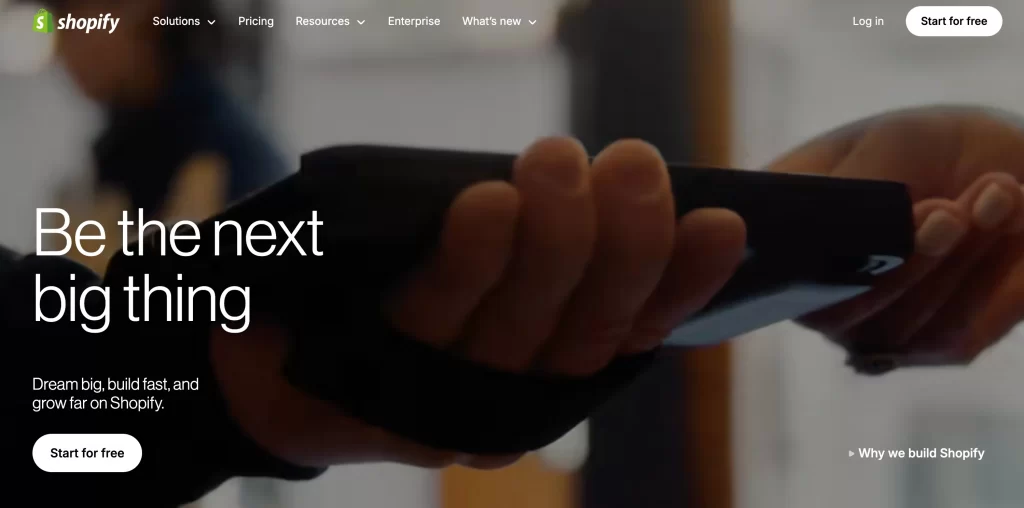
If you’re planning to sell print-on-demand products in 2025, the platform you choose will directly impact how much control you have, how quickly you can launch, and how far you can grow.
How Easy Is It to Launch a POD Business?
Quick verdict: Teespring wins – it’s faster to launch with minimal setup. Shopify takes more effort upfront but offers greater flexibility and long-term scalability.
When you’re just starting out, the time and effort it takes to launch your store can affect you business. Teespring and Shopify offer very different onboarding experiences: one is nearly hands-off, the other gives you full control.
Here’s a side-by-side look at what it takes to launch a print-on-demand business on Teespring vs Shopify, from signup to shipping:
| Step | Teespring (Spring) | Shopify + POD App |
| 1. Sign up | Create a free Teespring account | Create a Shopify account (14-day free trial) |
| 2. Upload designs | Upload artwork directly to products | Upload artwork via POD app (e.g., Printful) |
| 3. Select products | Choose from Teespring’s preset product catalog | Choose products from your connected POD app |
| 4. Publish store | Launch product pages on Teespring’s marketplace | Customize and publish your own Shopify storefront |
| 5. Customer orders | Teespring hosts checkout and processes transactions | Shopify processes payments and checkout |
| 6. Fulfillment | Teespring prints and ships automatically | POD app prints and ships automatically |
| 7. Customer service | Handled entirely by Teespring | Handled by you (or supported via third-party tools) |
As you can see, if your goal is to test an idea quickly, Teespring is hard to beat for its simplicity. There’s virtually no setup, and everything from fulfillment to customer service is handled for you.
But if you’re planning to build a real brand – one you own, grow, and scale over time – Shopify gives you the foundation you need. It may take a few extra steps to launch, but the payoff is long-term flexibility, higher margins, and full ownership of your customer journey.
At LitOS, we help founders bridge that gap: fast enough to launch, flexible enough to scale. If you’re migrating from a platform like Teespring or starting fresh, we can help you launch a Shopify store that’s ready for real business.
How Much Does It Cost and What About Profit Margins?
Quick verdict: Shopify wins – you pay upfront, but keep more profit per sale and control your margins as you scale. Teespring is free to start but cuts deep into earnings.
When evaluating Teespring vs Shopify cost, the real question isn’t just “what does it cost to start?”, it’s “what will I actually earn per sale?” Here’s how the two models compare when you run the numbers.
Teespring’s no-cost model
Teespring makes it easy to start without spending anything upfront. There are:
- No subscription fees
- No payment gateway setup
- No fulfillment costs upfront
Instead, Teespring sets fixed base prices for each product, and your profit depends on how much you mark up from there. But since you can’t control fulfillment costs, your margins are capped by default.
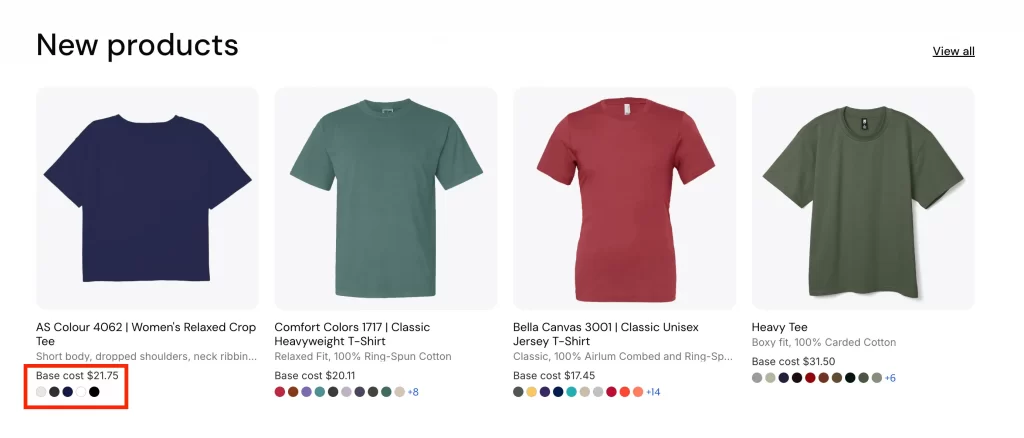
While it’s a solid model for creators testing ideas or selling to an existing audience, Teespring’s profit ceilings make it tough to grow or scale efficiently. You’re not just paying in margin, you’re giving up ownership of the store and customer journey.
Shopify’s monthly fees and app costs
Shopify uses a subscription-based model, starting at $39/month for the Basic plan, plus:
- Transaction fees (unless you use Shopify Payments)
- App fees if you use print-on-demand services like Printful, Printify, or automation tools
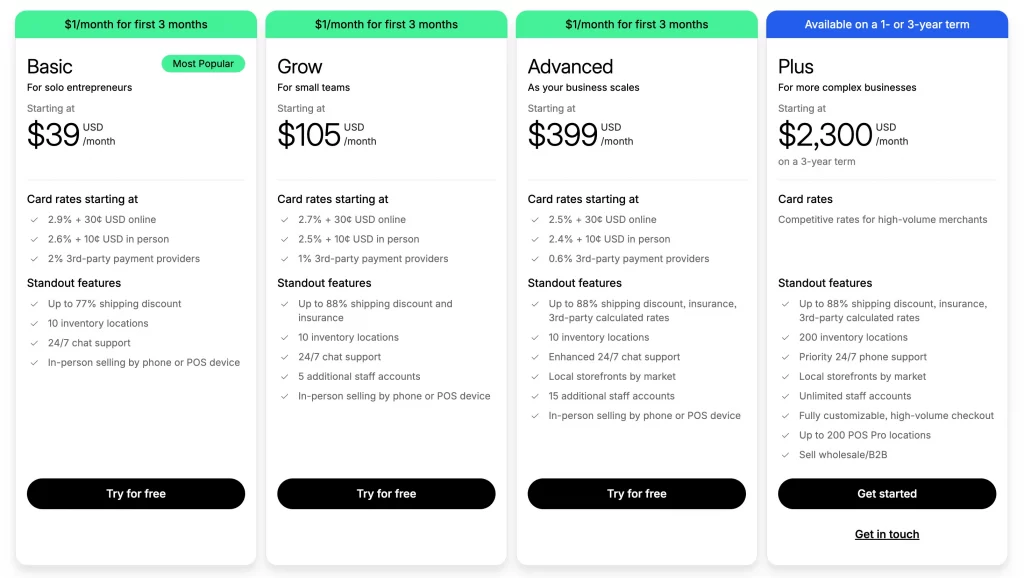
While this upfront cost may seem like a barrier, Shopify doesn’t take a cut of your product margins, meaning you have full control over your pricing, cost structure, and profits. Most POD apps are free to install and only charge for fulfilled orders, so you still avoid inventory risk.
If you sell just 20 shirts/month with a $15 profit margin, you already cover Shopify’s base cost, and keep everything beyond that.
What Are the Product and Store Options?
Quick verdict: Shopify wins – it offers a wider product range, flexible store structure, and full ownership. Teespring limits what you can sell and keeps you locked into its marketplace layout.
Choosing the right platform will affect what you can actually sell and how much control you have over the way you present it. Here’s how Teespring vs Shopify compare in terms of product variety and storefront setup.
Product catalog and store options on Teespring
Teespring offers a curated catalog of print-on-demand products you can customize and sell, mainly t-shirts, mugs, hoodies, stickers, posters, and a few digital products like eBooks.
What you can do:
- Upload a design and apply it to multiple products
- Choose color variants and set prices
- Sell digital items (eBooks, PDFs)
- Publish on a prebuilt Teespring store page
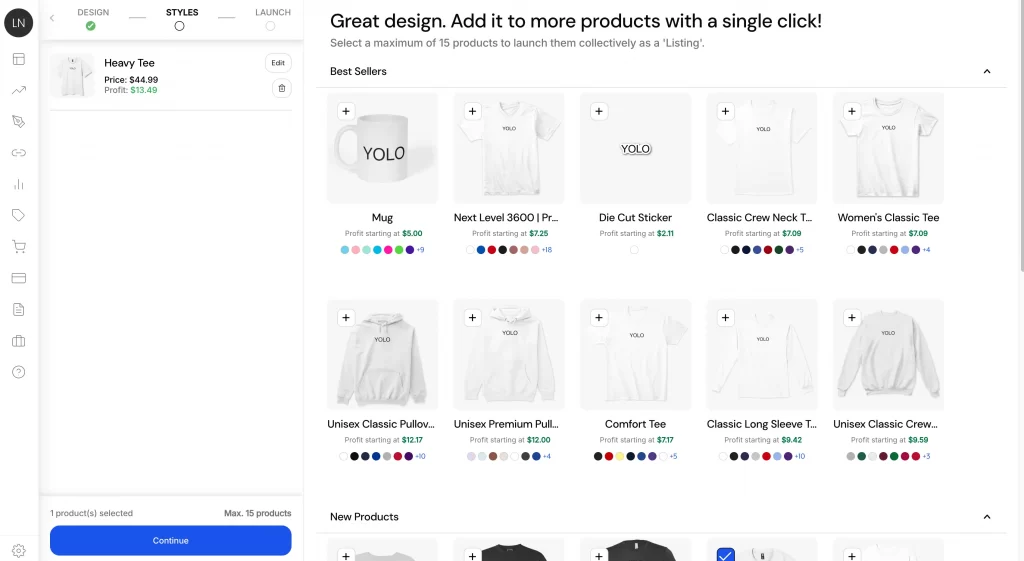
Limitations:
- You can’t add products from outside the Teespring ecosystem
- No multi-vendor, subscription, or bundling support
- No way to customize product page layout or group items by collection
- Storefront structure and navigation are fixed
This setup works if you want to test a few items quickly, but it doesn’t scale well when you want to expand your catalog, offer bundles, or tell a story around your products.
Product catalog and store options on Shopify
With Shopify, you can sell virtually anything: physical, digital, subscriptions, bundles, services, even NFTs. And you can connect multiple POD services (Printful, Gelato, Printify) to create a diverse product offering across multiple suppliers.
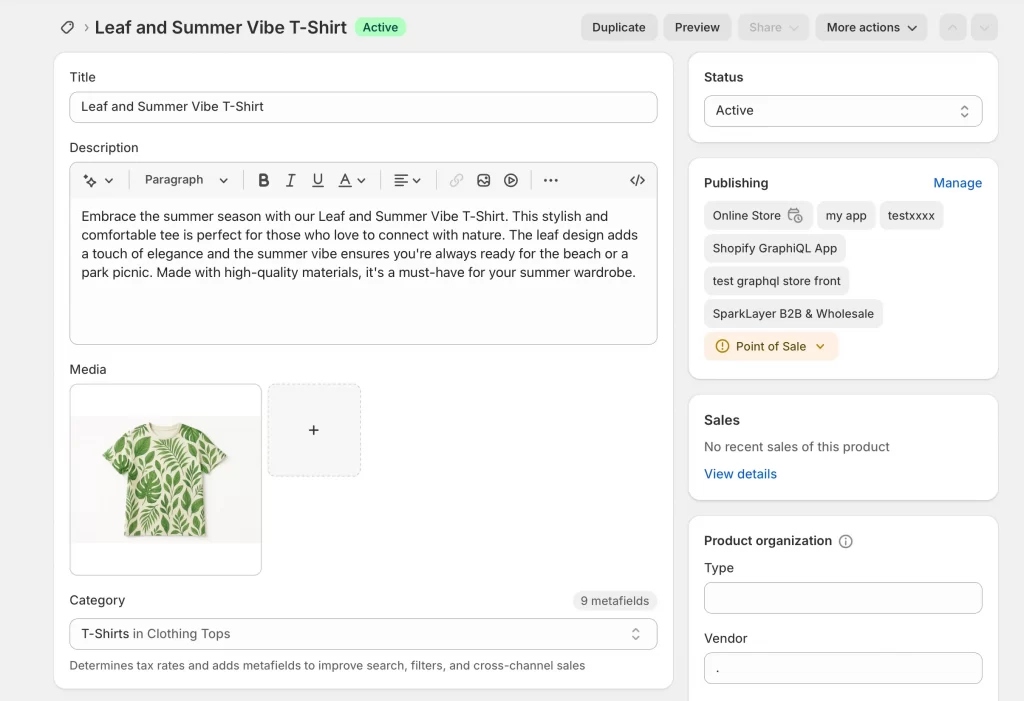
What you can do:
- Sell from any POD catalog, or create your own products
- Offer preorders, subscriptions, bundles, or gift cards
- Create smart collections, filters, and menus
- Customize product pages and collections to match your brand
- Scale to hundreds or thousands of SKUs with no structural limits
Shopify also supports multi-page store architecture, giving you room to build product lines, category pages, landing pages, and more, something Teespring doesn’t allow.
How Much Creative and Brand Control Do You Get?
Quick verdict: Shopify wins – it gives you full creative control to build a branded store experience, while Teespring locks you into a generic template with limited customization.
In eCommerce, design is the strategy. A well-branded store builds trust, improves conversion rates, and sets you apart from generic product pages. Here’s what each platform allows (and restricts) when it comes to brand control.
Storefront and product customization on Teespring
Teespring offers a streamlined selling experience, but it comes at the cost of creative freedom. You’re essentially listing your products on Teespring’s marketplace with limited options to stand out.
You can:
- Add a profile picture, store banner, and short bio
- Customize product designs (colors, text, placement)
- Use Teespring’s page layout and checkout structure
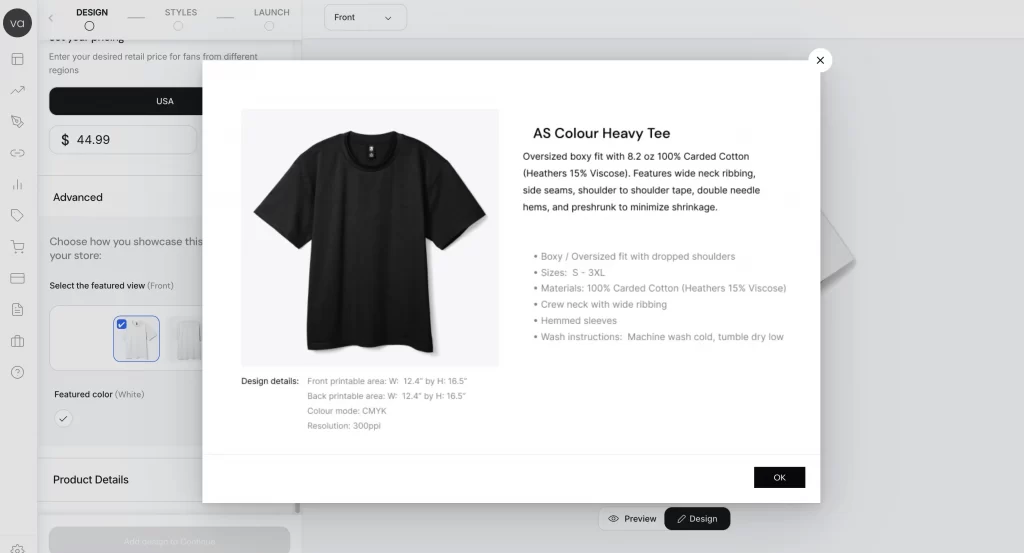
You can’t:
- Control the layout or theme of your store
- Customize the checkout experience
- Remove Teespring branding
- Add apps or advanced UX features
Even though you can sell under your store name, it still lives inside Teespring’s ecosystem. This limits how memorable (or differentiated) your brand can become.
Shopify’s full branding and design capabilities
Shopify gives you full control over how your store looks and performs. You can start with a ready-made theme or build something custom, either way, you own the design and the experience. Unlike Teespring, your store won’t look like a product listing on someone else’s platform.

And in Summer 2025, Shopify’s AI-powered tools make customization faster than ever — without sacrificing control:
- Shopify Sidekick acts as your built-in assistant. You can ask it to add new sections, recommend design changes, or even optimize your homepage for a campaign.
- Shopify Magic helps you auto-generate product descriptions, page headlines, and even marketing copy tailored to your tone and product type.
- The Horizon theme is designed for high-visual brands like fashion, fitness, and lifestyle POD stores.
With these tools, you can build and evolve your store faster and still maintain a fully custom, on-brand experience.
AI tools like Sidekick and Horizon make it easier than ever to build, but strategic design still separates the stores that convert from the ones that just look good. At LitOS, we help turn Shopify setups into fully branded, high-performing storefronts that grow with your business.
👉 Want to build a Shopify store with hands-on strategy? Let’s build it →
How Do the App Ecosystems and Integrations Compare?
Quick Verdict: Shopify wins – it offers a massive app ecosystem and integration flexibility across every part of your business. Teespring has limited, creator-focused integrations and no access to third-party tools.
Apps and integrations are what turn an eCommerce store into a business that sells. From marketing automation to print-on-demand suppliers, your platform’s ecosystem determines how far you can go and how fast you can scale.
Teespring’s creator-focused integrations
Teespring is built to serve creators, not business owners and its integration model reflects that. Most of its “apps” are embedded partnerships with major creator platforms designed for basic merch sales.
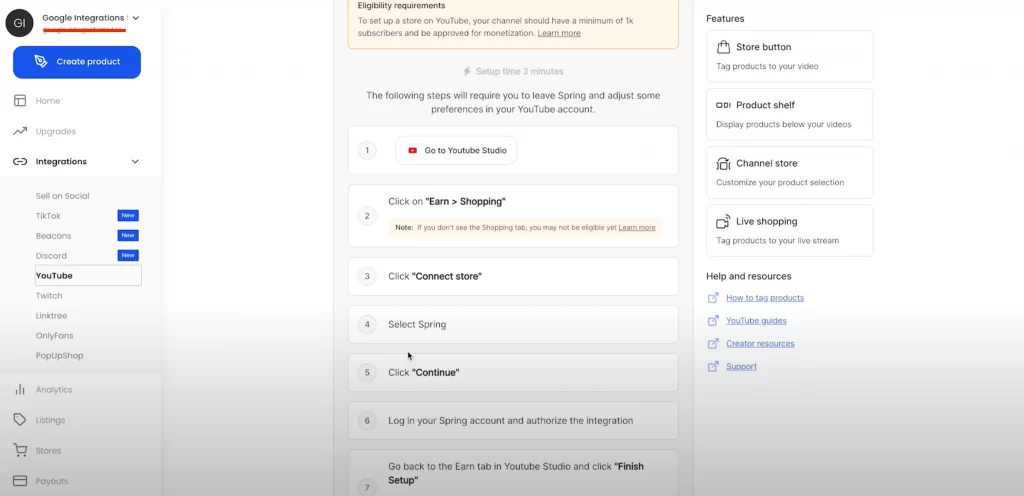
Key integrations include:
- YouTube Merch Shelf – display Teespring products directly under YouTube videos
- Twitch Merch Panel – sell merch to followers without leaving your stream
- Linktree – embed products in your link-in-bio
- TikTok Storefront (limited rollout)
These integrations are great for passive monetization, especially for creators who want a set-it-and-forget-it merch page. But there’s no support for tools like email marketing, product bundling, subscriptions or loyalty programs and A/B testing, analytics, or upselling.
You also can’t add custom apps or extend your storefront what you get is what you’re stuck with.
Shopify’s app store and extensive POD ecosystem
Shopify offers one of the most advanced app ecosystems in eCommerce, with over 8,000+ apps available through its official App Store. These apps cover every function imaginable, including:
- Print-on-demand: Printful, Printify, Gelato, SPOD, Apliiq, Gooten, and more
- Sales tools: Bundles, upsells, subscriptions, product recommendations
- AI tools: Smart product sorting, personalized search, conversion boosters
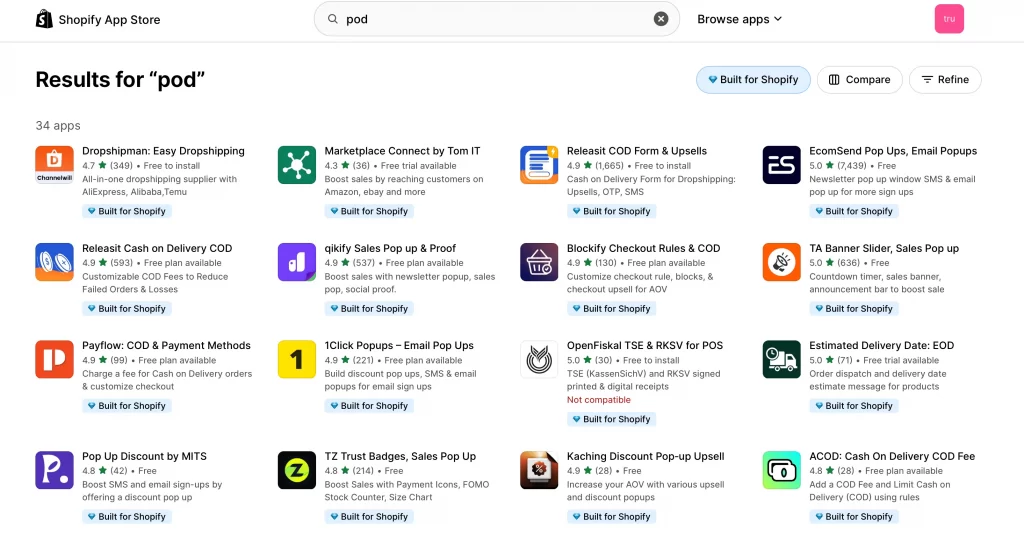
You can also build custom apps, use private apps or API integrations, integrate with marketplaces like Amazon, Etsy, TikTok Shop. The flexibility here is massive whether you’re optimizing your store’s performance or plugging into external sales channels.
Who Controls Your Customer Data Ownership?
Quick verdict: Shopify wins – you own your customer data and can build long-term relationships. Teespring keeps customer data within its platform, limiting your ability to remarket, retain, or grow repeat sales.
Customer data is one of the most valuable assets in eCommerce. It fuels your email list, powers retargeting, and helps you turn one-time buyers into loyal customers. The difference between Teespring and Shopify is simple: control vs access.
Customer data access and limitations on Teespring
When you sell through Teespring, the customer belongs to them, not you. You don’t get access to key customer data like:
- Email addresses
- Purchase history
- Abandoned carts
- Lifetime value or retention insights
Teespring handles customer communication, checkout, and post-purchase follow-up. While this reduces your workload, it also limits your ability to build a brand-led customer journey or run marketing campaigns. This is fine if your goal is short-term monetization but it’s a hard ceiling for brands that want to scale.
Customer data control and retention strategy on Shopify
With Shopify, you own the full customer record, from email and phone number to order history, location, and behavior. You can:
- Build segmented email lists
- Set up abandoned cart automations
- Track lifetime value and repeat purchase rate
- Run targeted upsells and retention campaigns
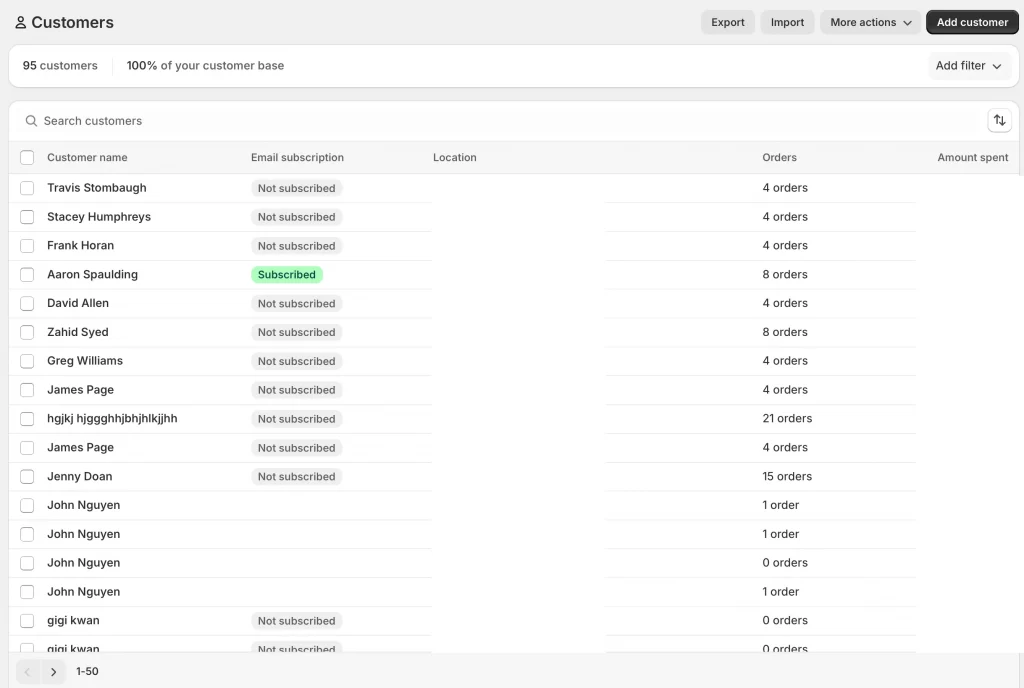
Shopify also integrates natively with CRM, review and loyalty apps, helping you build systems around your customer relationships. And the result is every sale you make becomes part of a feedback loop that powers the next one.
How Do SEO and Marketing Tools Compare?
Quick verdict: Shopify wins – it gives you full control over SEO, email, and performance marketing tools. Teespring offers minimal options and no ability to run serious marketing campaigns.
Marketing is what turns products into sales and SEO is how people find you organically. The platform you choose should support not just selling, but promoting and growing your store. In this area, the gap between Teespring vs Shopify is especially clear.
Marketing and SEO capabilities on Teespring
Teespring offers almost no built-in tools for marketing or SEO. You can share product links on social media, but beyond that, you’re limited.
What you can do:
- Share your store via a Teespring link
- Add brief product titles and descriptions
- Promote through YouTube or Linktree integrations (if eligible)
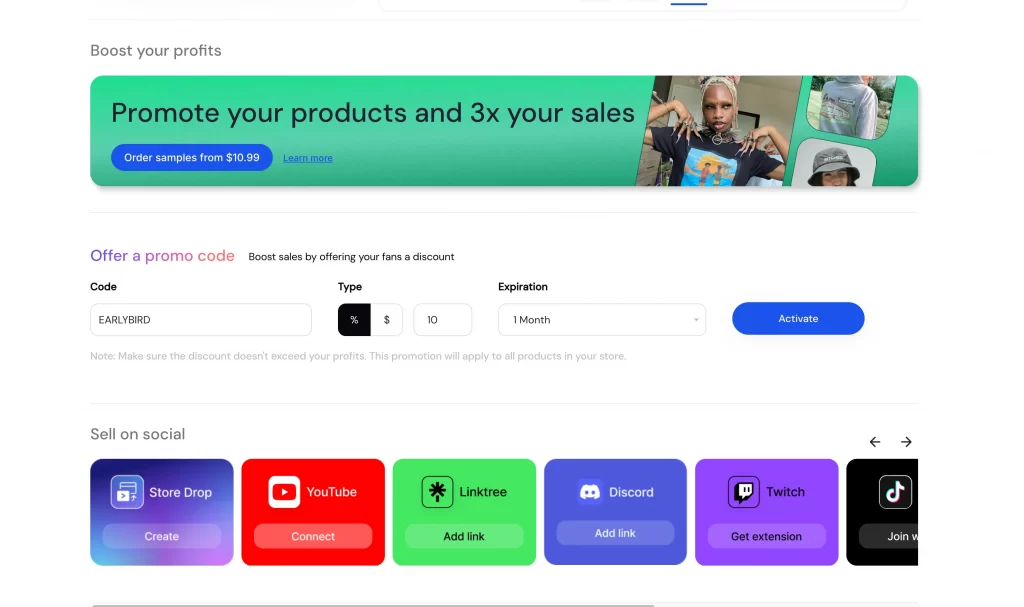
What you can’t do:
- Edit meta titles or URLs for SEO
- Run email campaigns or segment your list
- Add Google Analytics, Meta Pixel, or retargeting tools
- Control blog content, schema markup, or link structure
- Integrate with Klaviyo, Mailchimp, or ad platforms
This means no real visibility in search and no direct marketing funnel, making it hard to drive growth beyond your existing audience.
Marketing and SEO capabilities on Shopify
Shopify gives you a full suite of tools, both built-in and extendable via apps, to help you market and optimize for discovery.
You can:
- Edit meta titles, descriptions, image alt text, and URLs
- Set up custom redirects and structured data (schema)
- Create blog content and landing pages to rank in search
- Connect Google Analytics 4, Meta Pixel, TikTok Ads, Pinterest, and more
- Run email campaigns with tools like Klaviyo or Shopify Email
- Set up abandoned cart flows, SMS, pop-ups, and loyalty programs
- Use built-in or AI-assisted SEO recommendations
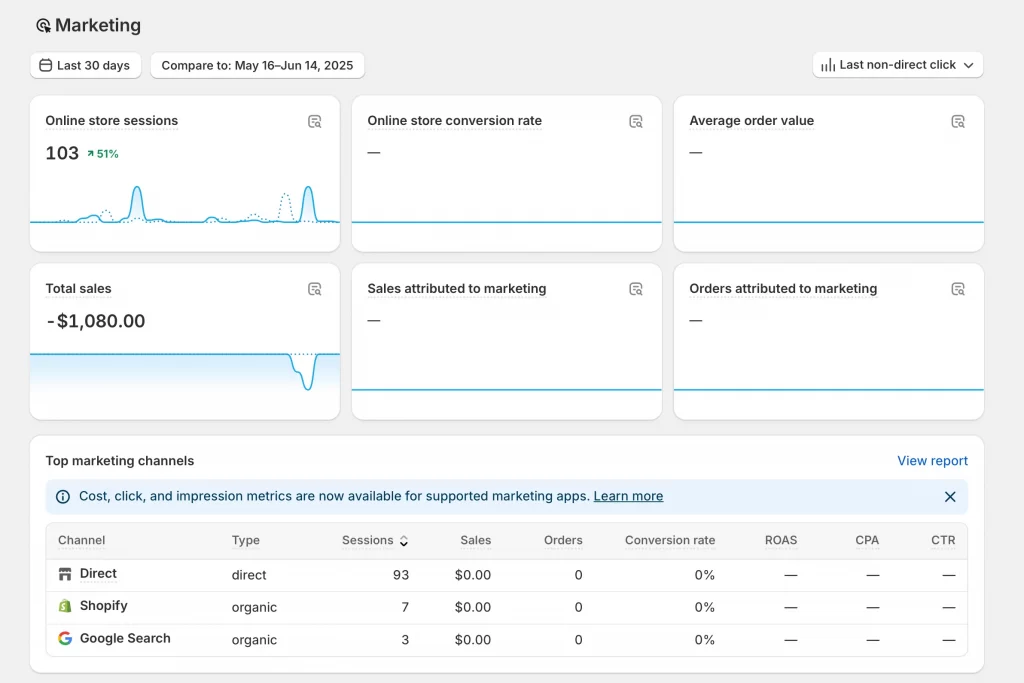
Shopify doesn’t just support marketing, it integrates your tools and lets you build marketing flows that adapt to customer behavior.
What Support and Platform Security Can You Expect?
Quick verdict: Shopify wins – it offers scalable infrastructure, direct merchant support, and full store ownership. Teespring handles everything for you, but you’re fully dependent on their platform with limited control.
When your store runs into issues, from product glitches to payment problems, the level of support and platform stability can make or break your momentum. Here’s how Teespring vs Shopify handles support, security, and long-term reliability.
Teespring’s hands-off model and platform dependency
Teespring is designed to take work off your plate. They handle fulfillment, customer service, and the platform infrastructure but that also means you’re giving up a lot of control.
How it works:
- Teespring manages buyer support and refunds
- You don’t handle orders, disputes, or chargebacks
- Platform outages, delays, or bugs are out of your hands
There’s no dedicated support for sellers beyond help docs and ticket submissions. You won’t get access to live chat or account-level assistance, which can make it frustrating if you’re facing urgent issues. And because your store lives on Teespring’s domain, you’re dependent on their policies, uptime, and platform rules. If Teespring limits your products, disables your account, or changes pricing structures, there’s not much you can do.
Shopify’s merchant-focused support and infrastructure
Shopify gives merchants real support and real autonomy. You’re running your own store, with infrastructure you control and multiple layers of help when needed.
What you get:
- 24/7 live chat and email support
- Access to a global network of Shopify Experts
- Extensive documentation, forums, and free tutorials
- Shopify Status page and uptime transparency
- Ownership of your domain, data, store structure, and code
The support experience is notably different from Teespring. Shopify provides direct help even on the Basic plan, and you can escalate issues quickly if something goes wrong.
Shopify also powers over 5 millions of businesses globally, including high-volume brands, meaning the platform is constantly optimized for performance, compliance, and security at scale. When something breaks, you’re not waiting in line behind thousands of creators using the same storefront template, you’ve got tools, control, and support.
Teespring vs Shopify: Which One Should You Choose?
If you’re still unsure which platform fits your goals, it helps to zoom out and think about what you actually want to build and how much control you’re ready to take on. Here’s how we break it down based on where you are and where you’re headed.
When should you choose Teespring
You want to:
- Start selling merch immediately with zero setup or tech knowledge
- Monetize an existing audience on YouTube, Twitch, or Instagram
- Test product ideas without investing in design, development, or marketing tools
- Avoid managing customer service, fulfillment, or your own website
Teespring is a good low-effort solution if you’re focused on simplicity and speed, not customization or long-term ownership.
When should you choose Shopify
You want to:
- Build a store you fully own and control (domain, branding, customer data)
- Offer a broader product mix using multiple POD apps or suppliers
- Grow beyond a creator audience into a full DTC brand
- Set up better marketing tools (SEO, email, ads, subscriptions, bundling)
- Scale with higher margins, retention, and flexibility
Shopify gives you the infrastructure and flexibility to build a business, not just a merch page.
Hey, you’ve this mesage from the LitOS team: If you’re starting on Teespring and planning to move up, or launching your first store and want it built right, we can help you import products, set up your Shopify store, and tailor it to fit your brand and growth plans.
Teespring vs Shopify: FAQs
Which is better, Teespring or Shopify?
Shopify is better if you want full control over your brand, customer data, and profit margins. Teespring is better for creators who want a easy and straightforward way to start selling merch with minimal setup or commitment.
What is the downside of Teespring?
Teespring limits your control over branding, pricing, and customer data. You also can’t expand your store beyond the built-in product catalog or integrate third-party marketing tools.
Does Teespring work with Shopify?
Not directly. Teespring is a standalone platform and doesn’t offer a native integration with Shopify. If you want to switch, you’ll need to manually import products or rebuild your store on Shopify using a POD app like Printful or Printify.
How much does it cost to sell on Teespring?
There’s no upfront cost, but Teespring takes a large portion of each sale based on product's base cost. For example, if you sell a t-shirt for $25 and the base cost is $17.74, your profit is only around $7.26, before any taxes or processing fees.
Is Teespring legit?
Yes, Teespring (now Spring) is a legitimate platform that has helped thousands of creators sell merchandise online. However, it’s important to note that it’s more limited in customization, branding, and data ownership compared to platforms like Shopify.
What platform is better than Teespring for POD?
Shopify is a better long-term platform for POD businesses. You can choose from multiple POD providers, set your own margins, control your branding, and use advanced marketing tools, all from one flexible, scalable storefront.
Final Words: Let’s Build Your POD Store the Right Way
Both Shopify vs Teespring let you sell print-on-demand products without managing inventory but they serve very different goals.
If you just need a quick way to launch merch without investing time or money, Teespring gets the job done. But if you’re serious about building a brand, owning your customer relationships, and scaling over time, Shopify is the platform built for that kind of growth.
Let’s build what’s next!
At LitOS, we help ambitious brands grow smarter on Shopify – with better tech, sharper strategy, and hands-on support that actually drives results. From migration to growth, we make the process seamless and built to scale.
Ready to build a Shopify POD store that reflects your brand and works from day one? Contact us now →
